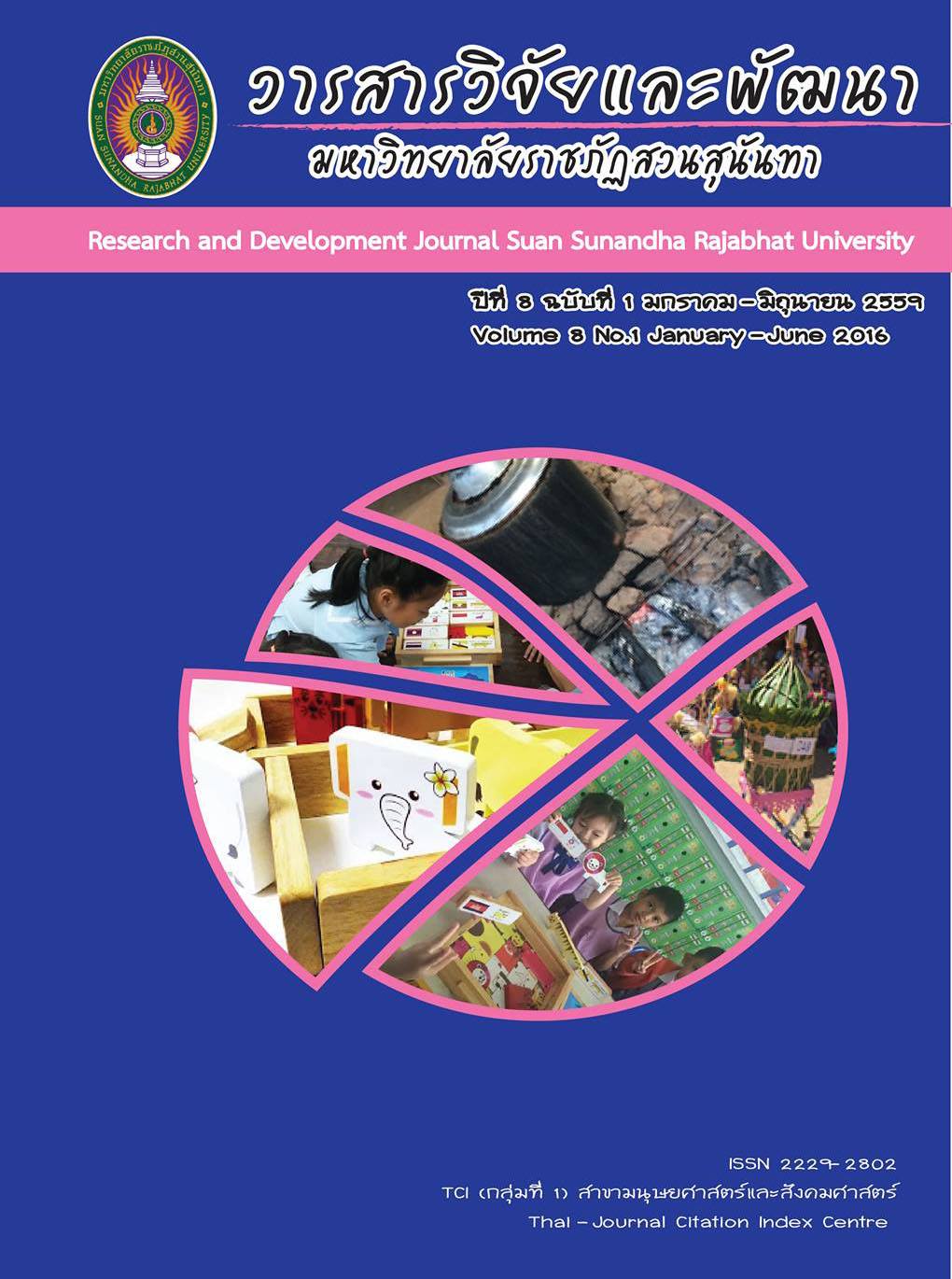การวิเคราะห์ผลตอบแทนทางการเงินในการตัดสินใจขายไม้ยางพาราของ เกษตรกรชาวสวนยางพาราภาคใต้ของไทย
DOI:
https://doi.org/10.53848/irdssru.v8i1.214752คำสำคัญ:
ผลตอบแทนทางการเงิน, เกษตรกรชาวสวนยางพาราภาคใต้ของไทย, การขายไม้ยางพาราบทคัดย่อ
วัตถุประสงค์หลักของการวิจัยในครั้งนี้เพื่อค้นหารูปแบบการขายไม้ยางพาราและเงื่อนไขในการตัดสินใจขายไม้ยางพาราของเกษตรกรชาวสวนยางพาราภาคใต้ของไทยผ่านการวิเคราะห์ผลตอบแทนทางการเงินที่เกษตรกรควรจะได้รับ ซึ่งใช้แบบสอบถามเป็นเครื่องมือในการเก็บรวบรวมข้อมูลจากเกษตรกรชาวสวนยางพาราภาคใต้ของไทยจำนวน 392 ราย ซึ่งสถิติพรรณนาถูกใช้เพื่อการวิเคราะห์ข้อมูลพื้นฐานในขณะที่สัมประสิทธิ์สหสัมพันธ์เพียร์สันถูกใช้ทดสอบสมมติฐานการวิจัยและการวิเคราะห์ความถดถอยเชิงพหุคูณถูกใช้เพื่อค้นหาปัจจัยที่มีอิทธิพลของการวิจัยในครั้งนี้ผลการวิจัย พบว่าเกษตรกรชาวสวนยางพาราภาคใต้ของไทยตัดต้นยางพาราเพื่อขายระหว่างอายุ 23 – 25 ปีเมื่อหน้ายางไม่มีความสมบูรณ์และไม่มีประสิทธิภาพในการให้น้ำยางได้อีกต่อไป โดยใช้มูลค่าเพิ่มเชิงเศรษฐกิจและระยะเวลาในการคืนทุน ในการวัดผลตอบแทนทางการเงินที่จะได้รับเพื่อตัดสินใจขายไม้ยางพารา ณ เวลานั้น ซึ่งรูปแบบการขายไม้ยางพาราที่นิยมใช้กันคือ การขายผ่านนายหน้า เจ้าของสวนยางพาราติดต่อโรงงานแปรรูปไม้ยางพารา และเจ้าหน้าที่จัดซื้อของโรงงานมาติดต่อซื้อไม้ยางพารา ขณะที่ผลการวิจัยยังพบว่า 9 เงื่อนไขหลัก (ความสมบูรณ์ของหน้ายาง คุณภาพไม้ยางพารา ผลตอบแทนทางการเงินที่ได้รับ เกษตรกรชาวสวนยางพาราต้องการปลูกปาล์มน้ำมันทดแทนยางพาราที่ปลูกอยู่ สภาพเศรษฐกิจ สังคม และชีวิตความเป็นอยู่ของเกษตรกรชาวสวนยางพารา อายุของต้นยางพารา ทำเลของพื้นที่ปลูกต้นไม้ยางพารา ราคาและการต่อรองราคาซื้อขายไม้ยางพารา และการจ่ายมัดจำเงินล่วงหน้าก่อนการโค่น) มีอิทธิพลและมีความสัมพันธ์โดยตรงเชิงบวกต่อผลตอบแทนทางการเงินในการตัดสินใจขายไม้ยางพาราของเกษตรกรชาวสวนยางพาราภาคใต้ของไทย ณ ระดับความมีนัยสำคัญ 0.01ผลการวิจัยในครั้งนี้สามารถถูกประยุกต์อย่างเป็นไปได้โดยรัฐบาลและบุคคลที่เกี่ยวข้องเพื่อให้ความรู้ความเข้าใจ และการสนับสนุน แก่เกษตรกรชาวสวนยางพาราในทุกภูมิภาคของไทยกับการได้รับผลตอบแทนทางการเงินสูงสุด
เอกสารอ้างอิง
(2012). Cost Management: A
Strategic Emphasis (6th .ed.). New
York: Irwin McGraw – Hill.
Fenske, J. (2012). Rubber Will not Keep in
This Country: Failed Development
in Benin, 1897-1921. Discussion
Papers in Economic and Social History
Oxford University.
Ismail, I. (2008). Economic Value Added (EVA)
versus Traditional Tools in Predicting
Corporate Performance in Malaysia.
Business Management, 7(18), 21-41.
Jitjan, S., Leamvijarm S. & Rittidech, P.
(2009).Internal Migration and
Development of Labor for Rubber
Plant Growing in Isan for
Community Economic
Development. Thailand, Research
Institute of Northeast Thailand Arts
and Culture Mahasarakham University.
Kaiyoorawong, S. & Yangdee, B. (2008). Rights
of Rubber Farmers in Thailand
under Free Trade. Thailand: Project
for ecological awareness building.
Manivong, V. & Cramb, R. A. (2007).
Economics of Smallholder Rubber
Production in Northern Laos.
Queenstown, New Zealand: Australian
Agricultural & Resource Economics
Society.
Viswanathan, P. K., Kadavil, T. G. & Jacob, C.
K. (2005). Crop Loss in Rubber Due
to Abnormal leaf fall: An Analysis
on the Economic Feasibility of Plant
Protection Measures in India, India.
Yamane, T. (1967). StatisticsAn Introductory
Analysis (2nd.ed.). New York: Harper
and Row.
Chotinant, N. (2012). Rubber Tree with
Wood Conversion Industry.
Suratthani: The Suratthani Centre of
Agriculture Development Research,
Ministry of Agriculture and
Cooperatives.
Kongrungchok, A. (2009). Management
Accounting. Suratthani: Graduate
School, Suratthani Rajabhat University,
Thailand.
Office of Agricultural Economics (OAE). (2014).
The Situations of Important
Agricultural Products and Trends in
2015. Bangkok: Ministry of Agriculture
and Cooperatives.
Office of the Rubber Replanting Aid Fund
(ORRAF). (2014). The Basic Guidance
for Enhancing Roles of Potential
Conversions and Marketing System
Development of Rubber Market in
the Level of Agriculturists. Bangkok:
Ministry of Agriculture and
Cooperatives.
Phae-Chana, P. et al. (2014). The Cutting
Hustle of Rubber Tree Down for
New Rubber Tree Series Planting for
Adding the Values of All Rubber
Products. Bangkok: The Department
of Agriculture, Ministry of Agriculture
and Cooperatives.
Phoonong-Aong, N. & Krongyutt, S. (2012).
Break Even-Point Analysis and Pay
Back Period of Rubber Planting: BanTad Sub-District, Udonthani
Province. The Special Problem of
Bachelor of Science (Industrial
Management), Udonthani Rajabhat
University.
Rubber Estate Organization (REO). (2014). The
Evolution of Rubber Tree. Bangkok:
Ministry of Agriculture and
Cooperatives.
Sirisuwatne, P. & Jindabot, T. (2013). Thailand
strategy of Export Industrial
Development for Competition in
International Markets. Executives,
33(2), 41-48
Sorat, T. (2012). Toward The ASEAN
Economic Community of Rubber
Product Industry. Bangkok: The
Federation of Thai Industries.
Srinavakul, R. (2012). Academic Information
of Rubber Tree Industry. Bangkok:
The Division of Subsidiary Industrial
Development, the Department of
Promotion, Ministry of Industry.
Thailand Productivity Institute (TPI). (2013).
The Standardized Enhancing Project
of Rubber Products and Rubber
Tree toward International Standard.
Bangkok: Ministry of Industry.
The Agricultural Futures Exchange of
Thailand (AFET). (2013). The
Fundamental Information of
Rubber. Bangkok: The Office of the
Agricultural Futures Trading
Commission.
The Department of Agriculture. (2012).
Energy Crop and Rubber Tree
Policy. Bangkok: Rubber Authority of
Thailand.
ดาวน์โหลด
เผยแพร่แล้ว
รูปแบบการอ้างอิง
ฉบับ
ประเภทบทความ
สัญญาอนุญาต
บทความที่ได้รับการตีพิมพ์เป็นลิขสิทธิ์ของ สถาบันวิจัยและพัฒนา มหาวิทยาลัยราชภัฎสวนสุนันทา
ข้อความที่ปรากฏในบทความแต่ละเรื่องในวารสารวิชาการเล่มนี้เป็นความคิดเห็นส่วนตัวของผู้เขียนแต่ละท่านไม่เกี่ยวข้องกับมหาวิทยาลัยราชภัฎสวนสุนันทา และคณาจารย์ท่านอื่นๆในมหาวิทยาลัยฯ แต่อย่างใด ความรับผิดชอบองค์ประกอบทั้งหมดของบทความแต่ละเรื่องเป็นของผู้เขียนแต่ละท่าน หากมีความผิดพลาดใดๆ ผู้เขียนแต่ละท่านจะรับผิดชอบบทความของตนเองแต่ผู้เดียว





